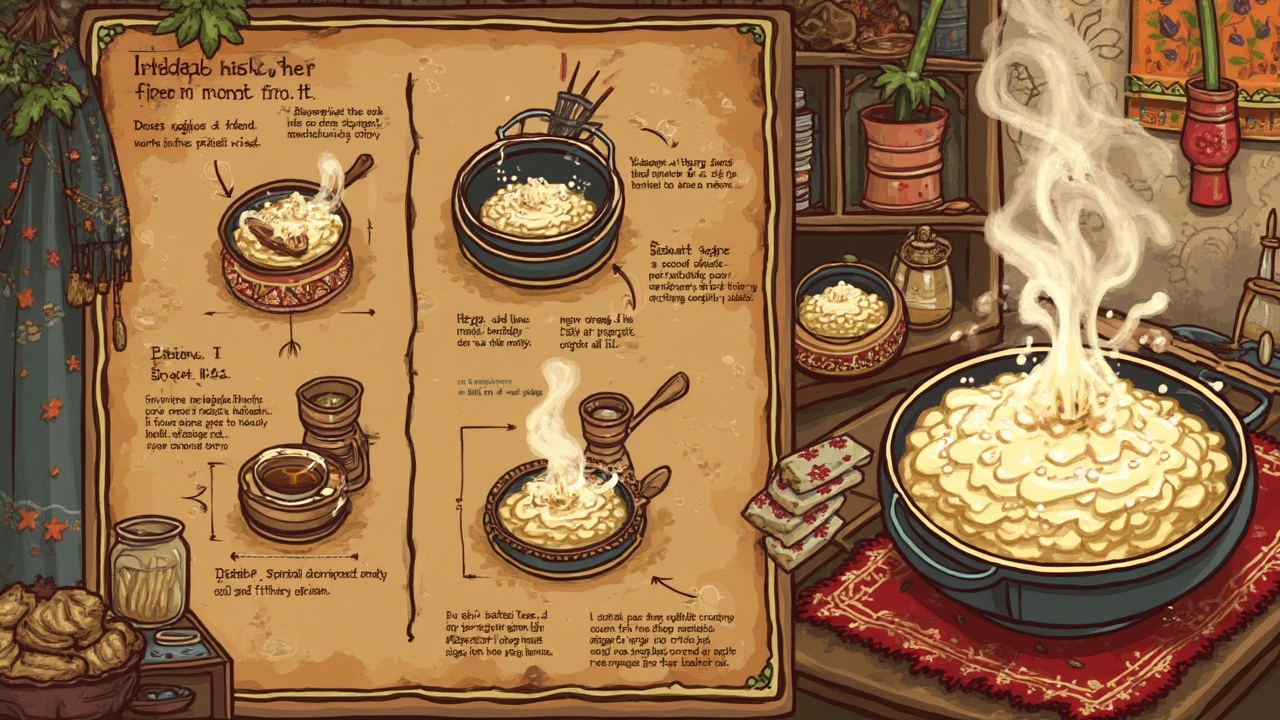Perfectly Fermented Dosa Batter in No Time
 Feb, 13 2025
Feb, 13 2025
Making the perfect dosa batter isn't rocket science, but getting it right without yeast can be tricky if you don’t know a few simple hacks. The key is to understand how natural fermentation works with just rice and lentils. It's not some magical process; it basically bubbles down to the right conditions that allow wild yeast and bacteria to do their job.
First off, ingredient ratio is super critical. You want about 3 parts rice to 1 part urad dal - that's your golden rule. This balance is what supports the beautiful fermentation process and produces those crispy yet fluffy dosas we all love. Now, go easy on the water when grinding; it should be a thick batter that doesn't drip off like thin soup.
- Understanding Dosa Fermentation
- Key Ingredients and Ratios
- Optimal Conditions for Fermentation
- Common Mistakes to Avoid
- Maintaining and Storing Batter
Understanding Dosa Fermentation
Fermentation is the heart of making great dosa batter. It's this natural process that transforms simple ingredients into something irresistibly flavorful and light. So, how does it work? Basically, wild yeast and lactic acid bacteria from the environment get into your batter and start to do their thing.
The magic happens when these microorganisms break down the carbohydrates in the rice and dal, turning them into alcohol and carbon dioxide. This is what gives your dosas that slight tangy taste and that perfect fluffiness. But it only works if the conditions are just right.
The Role of Temperature
Temperature is a biggie in the whole fermentation process. You ideally want to aim for an environment that's warm – around 30 to 35 degrees Celsius (86 to 95 degrees Fahrenheit). Too cold, and your batter will take forever to ferment; too hot, and you risk over-fermenting. An easy tip? Pop it in your oven with just the light on, or if it's sunny, let it sit on the counter near a window.
Humidity and Airflow Matter Too
Besides warmth, the surroundings should be moderately humid, as moisture helps maintain the activity of those microorganisms. For airflow, lightly covering your batter with a cloth or a loose lid is better than sealing it tight; you want a bit of air to find its way in.
Patience is Key
Fermenting dosa batter takes anywhere from 8 to 12 hours, depending on how cozy your kitchen is. You'll know it's ready when it looks bubbly and has increased in volume. And don't stress if it takes a tad longer. It's all about being patient—let nature take its course.
Here's a quick look at the fermentation process:
| Condition | Ideal Setting |
|---|---|
| Temperature | 30-35°C (86-95°F) |
| Time | 8-12 hours |
| Covering | Cloth or loose lid |
Mastering these basics can seriously up your dosa game, transforming your kitchen into a mini fermentation lab!
Key Ingredients and Ratios
Alright, let's get down to brass tacks: the ingredients. Crafting a perfect dosa batter is like building a house; you need a solid foundation with the right materials. For crispy, delicious dosas, the foundation is all about rice and urad dal.
Rice
You'll want to use a good quality short or medium-grain rice. Idli rice is perfect if you can find it, but regular rice works too. For a basic batch, use about 3 cups of rice. Rice brings the crispiness to your dosas.
Urad Dal
The superstar here is urad dal, also known as black gram. This ingredient is like the secret agent responsible for fermentation. You'll need about 1 cup for our base recipe. Urad dal holds the batter together and helps with fermentation.
Fenugreek Seeds
Add a teaspoon of fenugreek seeds. These little seeds pack a punch, encouraging the fermentation process and adding a subtle flavor touch.
Water Ratio
Follow the water ratio religiously. Add water gradually when grinding until you reach a thick but smooth consistency. Typically, this is about 1.5 to 2 times the total volume of your rice and dal combination.
Here's a quick look at what your ingredient list should be like:
- 3 cups of Rice
- 1 cup of Urad Dal
- 1 teaspoon of Fenugreek Seeds
- Salt to taste
Once the ingredients are sorted, soak the rice and dal separately for at least 4-6 hours. This might seem trivial, but it's crucial for achieving that smooth grind. Finally, during grinding, ensure that both the rice and dal are ground separately to a fine consistency before mixing them together. This process is essential for achieving the perfect fermentation and texture in your batter.

Optimal Conditions for Fermentation
Getting the fermentation just right for your dosa batter without yeast is all about the conditions you create. Think of it like setting the stage for a show; everything's got to be in sync.
Keep it Warm
Warmth is your friend here. The ideal temperature for fermenting dosa batter is between 30°C to 35°C (86°F to 95°F). In cooler climates, try storing the batter in your oven with just the light on, it acts as a cozy incubator. No fancy gadgets needed, just a simple old oven trick!
Time is Key
Usually, you want to let that batter sit for about 8 to 12 hours. If you're in a rush, soaking fenugreek seeds with your rice and lentils can actually speed things up since they help in fermentation.
Consistency Matters
You've got to watch the consistency. The batter should have a thick, pouring consistency. Not too runny and definitely not clumpy. It needs space to breathe—that's how it gets airy and light.
Avoid Common Pitfalls
- Don't overcrowd the container; it needs room to expand as it ferments.
- Make sure the container is covered but not airtight. A loose lid works, or just a clean cloth.
- Your salt game is important! Add salt after fermentation because it can mess with the process.
The magic really happens when all these elements come together. You don't need fancy ingredients or high-tech equipment—just a bit of patience and the right environment.
Common Mistakes to Avoid
Even seasoned dosa makers trip up from time to time. If your dosa batter ever doesn't rise or has a funky smell, you might be falling into some common traps.
Using the Wrong Water Temperature
One of the biggest blunders is not paying attention to water temperature during the soaking and grinding process. Cold water can slow down fermentation because the natural yeast needs warmth to thrive. Always use room temperature or slightly warm water to soak the rice and urad dal.
Grinding to the Wrong Consistency
Another frequent mistake is not getting the batter consistency right. If it's too runny, the fermentation process struggles, often leading to flat dosas. The batter should be thick enough to coat a spoon but still flow slowly off it. This consistency supports good fermentation and gives the right texture when cooked.
Ignoring Temperature and Humidity
Many overlook the importance of ambient conditions where the batter ferments. Dosa batter loves a warm spot, around 25-30°C (77-86°F). If your kitchen is chilly, tuck the bowl in your oven with just the light on, or wrap it with a warm towel. Remember, humidity helps too, so cover your batter with a loose lid or cloth to maintain moisture.
| Ideal Condition | Temperature | Humidity |
|---|---|---|
| Fermentation | 25-30°C (77-86°F) | High |
Not Allowing Enough Time
Lastly, patience is a virtue. Rushing the fermentation process is a no-go. Properly fermented batter needs about 8-12 hours, depending on your kitchen’s climate. If it's colder, it might take a bit longer, so give it the time it needs to do its magic.

Maintaining and Storing Batter
Once you've got your dosa batter perfectly fermented, the next big thing is keeping it fresh and just right for those lovely thin crepes. Storing it properly can be a lifesaver, especially when you're planning multiple dosa sessions.
Refrigeration Techniques
First off, refrigeration is your friend. Once the batter has fermented to your liking, pop it in the fridge. Cold temperatures slow down fermentation, so your batter won’t get overly sour. A good tip is to transfer it to an airtight container. This keeps out any funky fridge odors and prevents it from absorbing other food smells.
Consistency Checks
Keeping an eye on batter consistency is vital. Before each use, give it a good stir. The thicker top part might have set a bit, so mix it back to its initial consistency. If it’s too thick, just add a splash of water to loosen it up.
Time Frame for Usage
Don’t push the limits, though. For the best taste and texture, try to use the refrigerated batter within a week. Indian cooking aficionados even say the flavor keeps improving for the first few days post-fermentation.
Portion-wise Freezing
If you’ve made a huge batch and it looks like you won’t use it all soon, freezing is an option. Freeze in portions, so when inspiration for homemade Indian cooking strikes, you can defrost just what you need. Defrost it in the fridge overnight, and maybe adjust its thickness back with water.
Avoid Cross-contamination
Always use a clean spoon to remove the batter you need, avoiding any cross-contamination. Trust me, you don’t want any surprise flavors sneaking their way into your beloved batter.